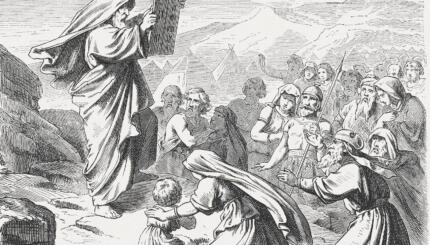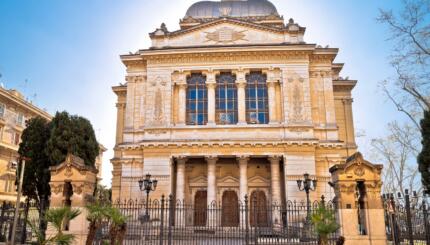The revolt launched by the priest Mattathias and later led by his third son, Judah Maccabee, was both a civil war and a war against an outside enemy. The company of Greek officers who arrived at Modi’in intending to enforce the king’s ordinances addressed Mattathias first, for he was held in high esteem by the villagers. They ordered him to begin the sacrificial offerings to the pagan idols, promising that in return he and his sons would be admitted to the circle of the king’s “friends.”
Mattathias refused outright. He killed a Jew who obeyed the command and then one of the king’s men. His flight to the mountains, together with his sons and his friends, marks the beginning of the uprising. Thus it appears that the revolt was directed first of all against those Jews who were willing to submit to Greek custom. Only then was it directed against the foreign occupier, the Syrian ruler who was forcibly imposing his culture upon the Jewish population and plundering the Temple and the land.
How the Rebels Fought
Our information about the rebellion is derived mainly from texts which eulogize Mattathias’s dynasty (I Maccabees) and in particular the figure of Judah, depicted as a lion of the desert (II Maccabees). We know much less of the Hassideans, the “pious,” who fought alongside Mattathias’s sons. What is obvious, however, is that one cannot win a war armed solely with religious purity. Compromise was essential from the beginning as, for example, Mattathias’s decision to fight on the Sabbath.
Moreover, the Seleucid army could not be defeated by guerrilla warfare alone. The Jewish rebels soon organized a real army modeled on the Greek military forces and capable, when fighting on its own terrain, of overcoming the Syrian troops. With great diplomatic skill they learned how to exploit the quarrels within the Seleucid dynasty, opportunely supporting some of the “usurpers” and obtaining various concessions in return.
Diplomacy and Propaganda
They also cultivated relations with distant nations, either for symbolic reasons, as in the case of the alliance with Sparta which was based upon the notion of affinity between the heirs of Lycurgus and the heirs of Moses, or for practical purposes, as in the alliance with Rome, the most formidable enemy of the Greeks. The negotiator with Rome was a Jewish historian of Greek culture, Eupolemus, whose father could have been the man who had negotiated with Antiochus III in 200 BC.
Maccabee diplomacy did not exclude propaganda. The Book of Daniel glorified the kingdom of the “saints” which would follow the four successive kingdoms of the beasts. Judith and Esther, heroines of the recent past, were depicted as the daughters of the bold prophetess Deborah, while Judah himself was presented as an incarnation of Joshua–judge and conqueror of the land.
The Revolution is Successful
The revolt achieved rapid success. At the end of the year 164 BC, the first Festival of Light (Hanukkah, [or] “inauguration “) was celebrated in a Temple purified of all pagan cults. (It is only through this festival that the revolt was transmitted to rabbinical posterity. The history of the revolt was retained only in Greek texts later preserved by Christian authors.) Until 141 BC, however, a Seleucid garrison remained in the citadel (Acra) of Jerusalem, protecting by its very presence those Jews who wished to maintain the Hellenistic way of life.
Meanwhile, the Jewish state was consolidating its achievements: “purifying” the land by imposing the circumcision of all infants, eliminating “arrogant spirits,” and capturing enemy cities such as Caspin on the Golan, and even tolerant Scythopolis (Beth‑Shean). The frontiers of the state were enlarged to include, even before its independence, the whole of the Land of Israel. Jonathan, and later Simeon [Maccabee], were recognized by the Seleucids as high priests and even as governors. But the Maccabees’ vision, the revival of the era of the Judges, was still but a distant dream.
Reprinted with permission from A Historical Atlas of the Jewish People edited by Eli Barnavi and published by Schocken Books.
Explore Hanukkah’s history, global traditions, food and more with My Jewish Learning’s “All About Hanukkah” email series. Sign up to take a journey through Hanukkah and go deeper into the Festival of Lights.



